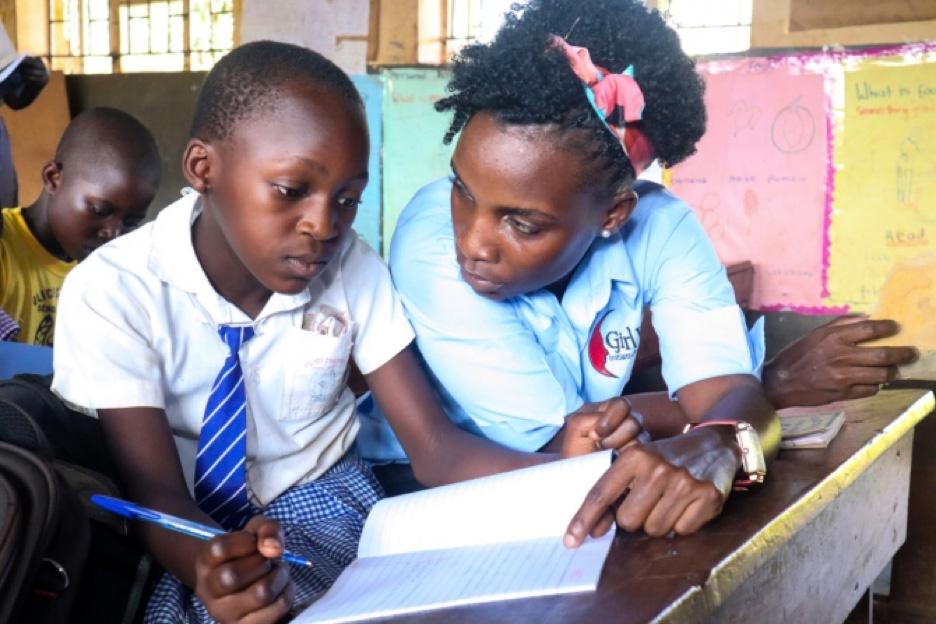 In many contexts, community-driven organizations offer girls in difficult circumstances a source of hope and chance at education by paying school fees, providing spaces for daycare, and taking on cases of gender-based violence by seeking legal justice on girls’ behalf. Community-driven organizations can also protect girls from female genital mutilation and early marriage and can support girls to develop and restore their power and agency through continuous training sessions. And that’s just the beginning.
In many contexts, community-driven organizations offer girls in difficult circumstances a source of hope and chance at education by paying school fees, providing spaces for daycare, and taking on cases of gender-based violence by seeking legal justice on girls’ behalf. Community-driven organizations can also protect girls from female genital mutilation and early marriage and can support girls to develop and restore their power and agency through continuous training sessions. And that’s just the beginning.
Localized approaches to education and educational support are contextually specific and often relevant to the many barriers that adolescent girls face when they are trying to attend school. Issues surrounding access to education are nuanced and multilayered, particularly in low- and middle-income country settings. At AMPLIFY Girls, we believe that it is imperative to resource community-driven organizations to support the holistic re-entry of girls into public education.
In October 2020, we launched a four-country study in Kenya, Rwanda, Tanzania, and Uganda aimed at understanding the barriers adolescent girls face when returning to school post COVID-19 and identifying potential pathways towards overcoming those barriers. This research provides an in-depth community-level assessment of the obstacles that could curtail adolescent girls’ education and collates regional evidence of best-practice interventions.
Our findings demonstrate that while girls’ experiences of the pandemic are multi-faceted and multi-layered, overarching feelings of isolation, fear, and hopelessness about the future emerged as key themes. The overwhelming majority of pregnant girls in the study reported becoming pregnant after engaging in transactional sex for basic goods—primarily basic needs, due to increased financial desperation brought on as a result of COVID-19. Of the goods sought for transactional sex, 61% were reportedly food, clothing, soap, or lotion; 19% accounted for menstrual hygiene products; 9% for other goods like sweets, school fees, or luxury clothing items; 6% for cellphones or other technology; and 5% of instances of transactional sex were a result of ‘peer pressure.’ From these results, we deduced that the most common cause of girls’ school dropout in the settings we surveyed begins with a lack of products to meet their basic needs (feminine hygiene products, shelter, food, or clothing). This vulnerability led girls to pursue sexually exploitative relationships with men who promised them money or goods in exchange for sexual favors, ultimately leaving many girls unintentionally pregnant and in some cases, unable to return to school.
Across the study cohort, girls reported pregnancy to be a determinant of their lives and future plans. In the majority of cases, the stigmatization, isolation, anxiety, and violence that pregnant girls faced made it impossible for them to return to school and augmented their experiences of other economic, social, and personal barriers common across the study population.
Girls are also experiencing protracted emotional and psychological trauma during the pandemic that will last beyond the period of school closures. The daily experience of violence, acute poverty, stress, anxiety, stigmatization, and insecurity has deteriorated girls’ mental health, making school return unlikely without psychosocial support and sustained and holistic care for multiple facets of their wellbeing.
We categorize the barriers to girls’ school return that emerged through our study as follows, in five key groups:
- Physical barriers: relocation and/or displacement, including unequal access to remote learning technologies and unsupportive learning environments.
- Economic barriers: pressure to earn income, loss of a parent or guardian, food insecurity, and/or lack of financial resources for school materials and costs.
- Health barriers: pregnancy and stigmatization, including girls’ experiences of physical and sexual violence, early marriage, and limited to basic health services, sexual and reproductive health information, and resources.
- Social barriers: hostile home environments and toxic school culture, negative peer pressure, and increased home responsibilities.
- Personal barriers: loss of hope, fears, and anxieties about school; lack of scholastic confidence should they return; lack of technical skills; and a deep sense of insecurity in themselves and their potential.
Girls know the solutions they need
In response to these barriers, girls themselves offered many important solutions and potential policies to support their continued learning. Common features of these recommendations included their holistic nature and deep care for the social and emotional aspects of girls’ wellbeing.
It is not enough for governments to declare that girls must go back to school; they must invest in systems that enable girls’ school re-entry and address causes of dropout.
Key recommendations girls provided to the global community include (expanded upon in the full report):
- Provide material resources and alleviate economic vulnerability. Economic support in the form of basic goods or school-related costs emerged as a cross-cutting recommendation by girls in all four countries. Increasing economic precarity was correlated with driving forms of sexual abuse and exploitation, leading to unintended pregnancies.
- Offer pathways for pregnant girls and young mothers to complete/continue their education. Given the high rates of teen pregnancy in their communities, girls felt it was urgent to provide young mothers and pregnant teens with options for continued learning. Recommendations focused both on returning pregnant girls to school by making schools more ‘girl-friendly,’ as well as providing skills-based learning opportunities such as vocational training and economic empowerment.
- Combat the stigmatization of pregnancy and teen-motherhood and that raise awareness about girls’ rights and needs. Pregnant girls surveyed unanimously felt that going back to learning would be unbearable because of the social stigma associated with pregnancy and teen motherhood. Girls recommended that family members, schools, and peers be sensitized about girls’ rights and needs.
- Provide psychosocial support, counseling, and mentoring. The recommendation for psychosocial support was unanimous amongst both pregnant and non-pregnant girls surveyed. Pregnant girls felt they needed mentoring and counseling about teen motherhood and encouragement to continue their education. Non-pregnant girls felt counseling and mentorship would help to encourage pregnant girls to return, despite prolonged absences and heightened anxieties.
- Establish effective community-based sexual reproductive health and rights (SRHR) initiatives. The overwhelming majority of girls reported that schools were the only place they could access information and resources pertaining to their sexual and reproductive health (SRHR) needs. When schools closed, many girls attributed rising pregnancies to the inability to access SRHR information and support. They recommended community-based SRHR counseling, services, and supplies in order to prevent future pregnancies.
- Make remote learning accessible (no-tech or low tech). Very few girls in our study were able to participate meaningfully in remote learning and felt that prolonged absences from education made school return exceedingly difficult. Girls requested support for accessing remote learning during ongoing and future shutdowns.
Girls’ education is globally recognized as the key to achieving gender equality, however, it is not a silver bullet. The Education 2030 Agenda recognizes that achieving gender equality requires an approach that ‘ensures that girls and boys, women and men not only gain access to and complete education cycles, but are empowered equally in and through education.’
To achieve SDG 4, we must not only focus on access to girls’ education but more importantly ensure that girls remain in school, develop as learners, and successfully transition to employment or further education. Centering community-driven development will enable us to ensure that all learners, especially young women access education.
Learn more about:
Margaret Butler has over 15 years of experience working alongside communities in Eastern Africa to support female leaders. After living in Rwanda and working with Partners In Health and The Clinton Foundation on health-related projects, Margaret founded Komera to support adolescent girls and their community. Margaret is also the co-founder of the East African Girls Leadership Summit, which brings together promising young women from across Eastern Africa to be effective change makers in the world. Noticing the need for a network of community-based organizations to share best practices and learn to scale ideas, Margaret co-founded AMPLIFY in 2017 alongside 18 other partners in East Africa. Margaret holds a BA from the University of Washington, a B.Ed from the University of British Columbia and a Masters in International Educational Development from Teachers College, Columbia University.

